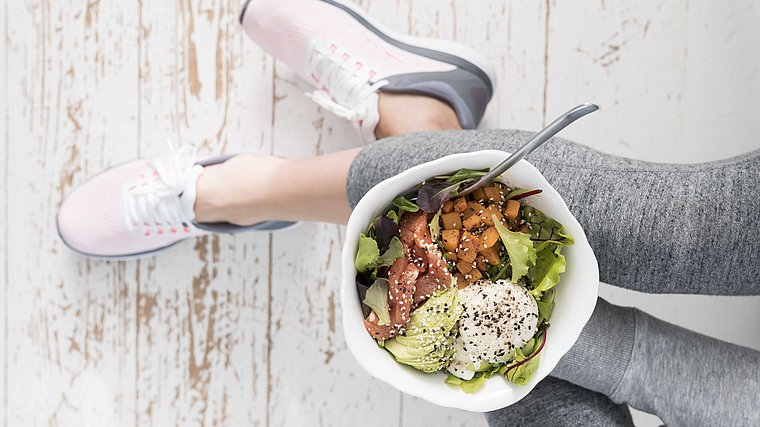Who is it recommended for?
Diet for the active, as the name suggests, is mainly aimed at people who engage in regular, recreational or semi-professional physical activity. This plan will work perfectly for those who take up general training in order to improve their strength, endurance and aerobic fitness.
Principles of the diet
When planning their nutrition, those who regularly engage in physical activity should focus on, among others, choosing the right energy content of the diet, as well as the amount of protein, carbohydrates and fluids. Only a properly balanced diet plan will allow you to reap the full benefits of exercise, such as improved fitness and overall performance, but also support the prevention of cardiovascular diseases or cancer.
- Energy value of the diet
The calorie content of the diet will not only translate into body weight, but more importantly into energy resources during exercise. Therefore, an important element to consider when determining the calorie content of a diet plan is to take into account the energy expenditure associated with training. Both too low and too high a calorie supply can contribute to delaying the achievement of goals. The plan should include additional meals to balance the calories burned during activity, or increase the energy value of an already planned dish accordingly. This is extremely important, especially for weight loss diets. Too large a calorie deficit can have negative consequences and cause, for example, a decrease in muscle mass and even deterioration of exercise capacity, lower energy, general weakness and nutritional deficiencies.
- Carbohydrates – the type and timing of their consumption
Carbohydrates are the main source of energy during exercise, so they should cover a significant portion of energy needs, especially for physically active people. The basis of the diet should be whole grain products (bread made from whole grain flour, all kinds of groats, brown rice, whole grain pasta), fruit and vegetables.
Depending on the calorie content of the diet and the time of eating, products with lower fibre content and higher glycemic index may also be included in the menu. And so:
- if you have 3-4 hours until the scheduled activity, you can reach for less processed cereals, for example coarse groats such as pearl or buckwheat, which will take longer to digest and thus the energy from them will be released more slowly;
- when there are only 1-2 hours left before the workout, it is advisable to choose products with lower fibre content, such as a banana, millet groats, a sandwich with jam or a fruit smoothie.
After exercise, especially if the next activity is planned for the following day, complex carbohydrates are recommended. Dishes should be based on unrefined grain products with added protein, such as lean meat or fish with a carbohydrate addition or a salad with groats/pasta.
- Protein
Lean meat, fish, eggs, milk, low-fat dairy products and legumes are other foods that should be included in a diet for active people. They provide building blocks (amino acids) for enzymes, neurotransmitters, transport proteins, immune system cells, and tissues. All of these elements will directly or indirectly affect exercise capacity, if only by maintaining the body’s water-electrolyte balance. In addition, protein optimises post-workout recovery of muscle tissue and supports the restoration of glycogen (the spare form of carbohydrates used as the main source of energy during exercise). But note! When reaching for plant-based protein sources, such as legumes, it is important to remember that they do not provide all the essential amino acids. Therefore, in order to increase the biological value of the plant protein consumed, it is worth combining it with grain products. Such a combination will work well in both savoury and sweet dishes, such as vegetarian chops, stews, cakes or brownie.
- Fluids
Physically active people have an increased demand for fluids, which has to do with increased sweating during training. Even slight dehydration can translate into sports performance, so it is important to ensure proper fluid supply during exercise. It’s a good idea to weigh yourself before and after the workout, and ensure that the difference in body weight is no more than 1 percent. In addition, if the activity lasts more than 60 minutes, you can consider drinking isotonic drinks during the workout.
Proper hydration should be kept in mind throughout the day, not just around workout time. If you have trouble with this or don’t know if you’re drinking enough water, it’s a good idea to add the fluids you drink to an app that will help you monitor your hydration levels and let you know it’s time to take a few sips.
What products are included in the diet?
The MultiLife plan for active people is based on meals containing carbohydrates and good quality protein, such as oatmeal, millet groats, pasta, kashotto, and meat and fish with side dishes. Snacks include smoothies, fruit, dried fruit and nuts, and dark chocolate.
References:
- Bean A.: Żywienie w sporcie. Poznań: Zysk i S-ka Wydawnictwo; 2008
- Momma H., Kawakami R., Honda T. Sawada S.: Muscle-strengthening activities are associated with lower risk and mortality in major non-communicable diseases: a systematic review and meta-analysis of cohort studies. British Journal of Sports Medicine Published Online First: 28 February 2022. doi: 10.1136/bjsports-2021-105061
- Jeukendrup AE, Gleeson M. Sport Nutrition: An introduction to energy production and performance. Human Kinetics, 2010
- Thomas DT, Erdman KA, Burke LM. American College of Sports Medicine Joint Position Statement. Nutrition and athletic performance. Med Sci Sports Exerc. 2016;48(3):543-568
[1] According to “British Journal of Sport Medicine”
